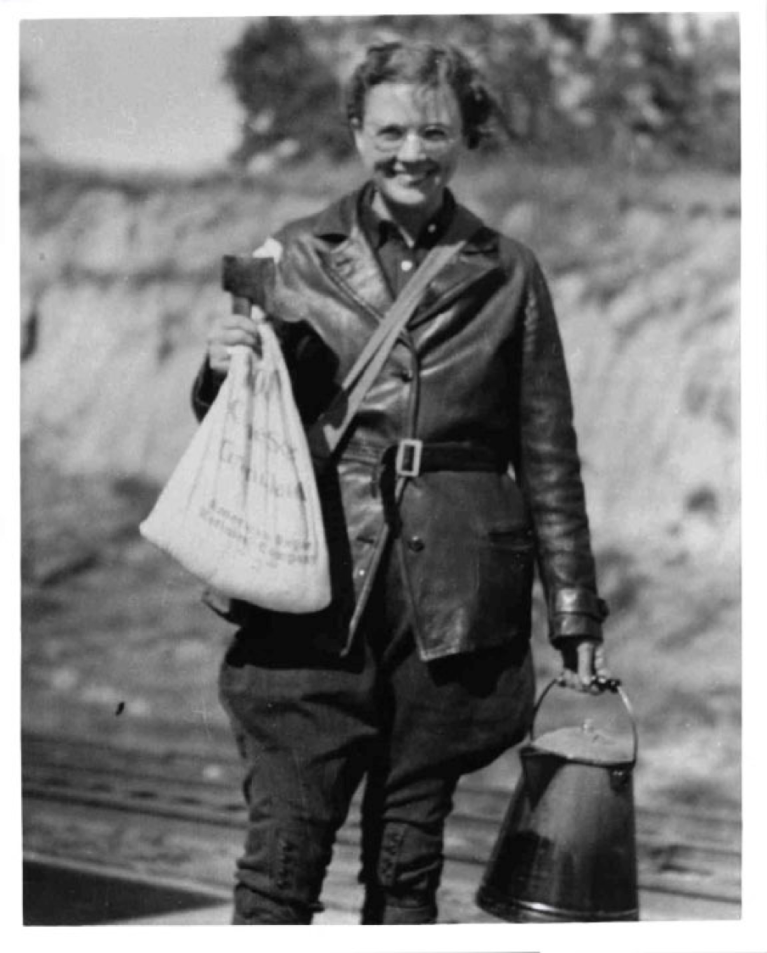Mary Talbot, Pioneering Entomologist
Terry McGlynn is the Editor-In-Chief of Small Pond Science, a collaborative blog. In recognition of Ada Lovelace Day 2017, he wrote this profile of entomologist Mary Talbot, cross-posted here with permission and minor edits.
We’ve provided some dates and other information below Dr. McGlynn’s post.
Mary Talbot, pioneering ecologist and myrmecologist
by Terry McGlynn, Professor of Biology at Cal State Dominguez Hills
Small Pond Science (blog), Leaflitter.org (lab page), @hormiga (twitter)
Mary Talbot originated the field of physiological ecology. Looking over the history of Talbot’s rigorous and experimental work on the physiological ecology of ants, it’s clear that she first generated big ideas in this realm and backed them up with integrative work in the lab and the field, publishing this work in highly visible journals. (The label of “the father of comparative physiology and integrative biology” is more often given to Knut Schmidt-Nielsen, who also did lots of fine work.)
Mary Talbot was an experimental ecologist in an era before experimental ecology became vogue. After establishing herself as an expert in her field, she shifted to work at the E.S. George Reserve of the University of Michigan for three decades, collecting integrative data on phenology and community structure that has yet to be paralleled in our field to date.
Mary’s academic path was non-traditional (as the traditional route that men took was not accessible). She did her undergraduate work at Denison University, and then earned her Master’s in Entomology from Ohio State. She taught in temporary positions at a variety of universities before she started her PhD at the University of Chicago during The Great Depression. Shortly after receiving her doctorate, she accepted a position at Lindenwood College for Women, where she conducted research and taught for the remainder of her career. Judging from mentions of her work by peers in the myrmecological community, her work and talent was held in the highest esteem, however this was not a time when women were provided the opportunity to run their own labs in entomology departments in research institutions. (Some folks might be amazed at the quality and quantity of science that she did within the walls of a teaching-focused institution. I would guess that regular readers of Small Pond Science will be less surprised.)
In the Summer of 2017, ant ecologists gathered in a symposium to honor the discoveries and contributions of Mary Talbot. We shared how our contemporary research — particularly the ecological and evolutionary responses to climate change— is directly informed by the discoveries of Talbot. Her papers are not cited thousands of times, though the central ideas that she developed permeate the field. Her contemporaries often referred to her ideas in conversation, though they often failed to appropriately cite her work. She was regarded as a member of the academic community as an unparalleled natural historian of ants, but her contributions were much greater, shaping our thinking on a wide range of topics, including how animals evolve and adapt to variation in weather and climate, and the relationships among animal life histories and the assembly of ecological communities. As an ant biologist, reading her papers anew makes me realize how many ideas in the latter half of the 20th century came straight from Talbot, but we often failed to value these contributions even as we relied on them.
At the moment, Dr. Talbot’s page on Wikipedia is a mere stub that could use expansion,* feel free to have at it. There are additional details about her career in this biography, in an appendix attached to a publication that was compiled after her death, summarizing some her work at the George Reserve.
There are oodles of talented women myrmecologists nowadays, though a survey of the literature shows that underrepresentation persists, particularly among taxonomists. The academic culture in my own subfield still is not equally welcome to men and women, and by recognizing this fact we can identify changes to become more inclusive.
* Editor’s Note: This is true of many ecologists’ pages on Wikipedia. We join Dr. McGlynn in encouraging efforts here!

Mary Talbot, November 30, 1903 – April 16, 1990
Education and Career Highlights
- B.S., Denison University, 1925
- M.S., Ohio State University, Columbus, 1927
- Instructor, University of Omaha, 1927-28
- Instructor, Stephens College, Columbus, MO, 1928-30
- Ph.D., University of Chicago, 1933
- Instructor of Botany, Lindenwood College, 1936-?
- Professor of Botany, Lindenwood College, ?-1968
- Researcher at E.S. George Reserve, 1952-~1978
Selected Contributions
1934. Distribution of ant species in the Chicago region with reference to ecological factors and physiological toleration. Ecology 15(4):416-439. Ph.D. Dissertation. (At Wiley Online Library.)
1946. Daily Fluctuations in Aboveground Activity of Three Species of Ants. Ecology 27(1):65-70. (At Wiley Online Library.)
1951. Populations and Hibernating Conditions of the Ant Aphaenogaster (Attomyrma) Rudis Emery 1 (Hymenoptera: Formicidae)
Annals of the Entomological Society of America 44(3):302-307.
1957. Population Studies of the Slave-Making Ant Leptothorax Duloticus and Its Slave, Leptothorax Curvispinosus Ecology 38(3):449-456. (At Wiley Online Library.)
1979. Social Parasitism Among Ants at the E.S. George Reserve in Southern Michigan. The Great Lakes Entomologist: Vol. 12 : No. 2 , Article 7, pages 87-89.
Dr. Talbot’s numerous publications from her 30 years at the E.S. George Reserve are listed on the reserve’s publications page.
According to Kannowski (2012), “Her ant collections are now at Harvard University and the University of Missouri, St. Louis. A synoptic set of her collections from the George Reserve are in the Division of Insects of the Museum of Zoology at the University of Michigan.”
References
Kannowski, Paul B. 2012.A Myrmecologist’s Life: An Appreciation of Mary Talbot (with photos), in The Natural History of the Ants of Michigan’s E. S. George Reserve. Miscellaneous Publications. Museum of Zoology, University of Michigan. pp. 211–215.
Mary Talbot (entomologist), page on Wikipedia.
